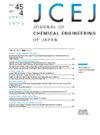混凝剂浓度对海藻酸盐离子交联湿纺大豆蛋白基肉替代品纤维的影响
IF 1.2
4区 工程技术
Q4 ENGINEERING, CHEMICAL
引用次数: 0
摘要
利用植物源性材料生产肉类替代品作为可持续蛋白质供应的解决方案正引起人们的关注。我们以前报道过用海藻酸盐离子交联和湿纺丝相结合的方法制备大豆蛋白基纤维。在本研究中,我们重点研究了混凝剂溶液中的钙离子浓度和纺丝溶液中的海藻酸盐浓度,这是海藻酸盐凝胶化的决定因素。随着钙离子浓度的增加,纤维直径减小,这可能是由于混凝剂溶液渗透压差导致纤维脱水和快速凝胶作用抑制纤维膨胀所致。纤维的硬度随藻酸盐浓度和钙离子浓度的增加而增加,弹性随钙离子浓度的增加而增加,随藻酸盐浓度的增加而降低。通过纺丝和混凝液的组合来控制纤维的结构和质地,可以提高其在肉类替代品中的适用性。本文章由计算机程序翻译,如有差异,请以英文原文为准。
Effect of Coagulant Concentration on Soy Protein-Based Fiber for Meat Substitute by Wet Spinning Combined with Ionic Cross-Linking of Alginate
Meat substitutes production using plant-derived materials is attracting attentions as a solution for sustainable protein supply. We have previously reported the fabrication of soy protein-based fibers by combination of wet spinning and ionic cross-linking of alginate. In this study, we focused on the calcium ion concentration in the coagulant solution and alginate concentration in the spinning solution, which are determinant factors for in the gelation of alginate. The fiber diameter was reduced by increasing calcium ion concentration, probably due to the dehydration from fiber induced by osmotic pressure difference with coagulant solution and the suppression of swelling of fiber by the rapid gelation. The hardness of fibers evaluated by texture analysis increased as the concentrations of alginate and calcium ion increased, while the springiness increased with increasing calcium ion concentration but decreased with alginate concentration. The controlling the structure and texture of fibers by the compositions of spinning and coagulant solutions would improve their applicability to meat substitutes.
求助全文
通过发布文献求助,成功后即可免费获取论文全文。
去求助
来源期刊

Journal of Chemical Engineering of Japan
工程技术-工程:化工
CiteScore
1.70
自引率
12.50%
发文量
51
审稿时长
1.9 months
期刊介绍:
The Journal of Chemical Engineering of Japan (JCEJ) is a monthly publication in English of the Society of Chemical Engineers, Japan. The first issue appeared in 1968. JCEJ publishes timely original research in the broad field of chemical engineering ranging from fundamental principles to practical applications. JCEJ is an international research journal and invites your contributions and subscriptions.
All areas of chemical engineering are covered, including:
Physical Properties and Physical Chemistry,
Transport Phenomena and Fluid Engineering,
Particle Engineering,
Separation Engineering,
Thermal Engineering,
Chemical Reaction Engineering,
Process Systems Engineering and Safety,
Biochemical,
Food and Medical Engineering,
Micro and Nano Systems,
Materials Engineering and Interfacial Phenomena,
Energy, Environment, and
Engineering Education.
 求助内容:
求助内容: 应助结果提醒方式:
应助结果提醒方式:


